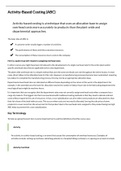Other
ACC7313_450 Accounting Concepts II/ Activity-Based Costing (ABC) notes questions and answers
- Course
- Activity-Based Costing
- Institution
- Algonquin College
Activity-Based Costing (ABC) Activity-based costing is a technique that uses an allocation base to assign overhead costs more accurately to products than the plant-wide and departmental approaches. The basic idea of ABC is: Here is a quick recap with respect to assigning overhead costs: In ot...
[Show more]



